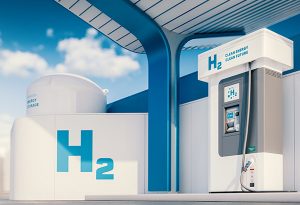Hydrogen: The fuel of the future

A type of energy source generated from hydrogen gas, hydrogen fuel can be produced through various methods, including electrolysis, steam methane reforming, and gasification. When hydrogen fuel is burned, it releases energy in the form of heat and produces only water as a by-product, making it a clean and environmentally friendly fuel. The electrolysis process involves using electricity to split water into hydrogen and oxygen. This process can be powered by renewable energy sources such as solar or wind power, making it a clean and sustainable way to produce hydrogen.
Hydrogen can also be produced from natural gas, coal, or biomass through steam methane reforming. This process involves reacting methane with steam to produce hydrogen gas and carbon dioxide. Though widely used, this method is not clean or sustainable because it generates greenhouse gases.
Hydrogen fuel can be used as transportation fuel for vehicles such as cars, buses, and trains. It can also be used to generate electricity in fuel cells, which can be used to power homes and businesses or to provide backup power for critical infrastructure.
Hydrogen fuel has several advantages, such as high energy density, ability to produce raw materials of different production methods, and the ability to produce only water when burned, making it a clean and environmentally-friendly fuel.
The development of a hydrogen fuel industry in a country will depend on a variety of factors, including the availability of infrastructure for producing, storing, and distributing hydrogen fuel, economic viability, and the presence of regulatory frameworks that support the development and adoption of hydrogen as a fuel source. In Nepal, regulatory frameworks and laws for hydrogen fuel production are lacking.
Hydrogen fuel production and distribution infrastructure are still in the early stages of development in many countries, including Nepal. That being said, there is potential for hydrogen to play a role in Nepal’s energy mix. Hydrogen has several characteristics that make it an attractive fuel source, including its high energy density, its ability to be produced from a variety of feedstocks using a range of production methods, and the fact that it produces only water when burned, making it a clean and environmentally-friendly fuel.
As technology and infrastructure for hydrogen fuel production and distribution continue to develop, we may see the establishment of hydrogen fuel plants in Nepal. However, it is essential to note that the adoption of hydrogen as a fuel source will depend on various factors, including economic viability, regulatory frameworks, and consumer demand.
Private sector initiation
Some interest groups in Nepal recently organized the first-ever Nepal Green Hydrogen Summit (NGHS), in association with different entities like MIT Group Foundation, Melbourne Institute of Technology, Kathmandu University, and government ministries, including the Ministry of Finance and the Ministry of Energy. The summit’s purpose included facilitating the development of the legislative setup and framework studies on Nepal’s potential for producing and distributing hydrogen energy.
Indian plans
India has recently been exploring the potential for hydrogen as a fuel source and has taken steps to develop a hydrogen fuel infrastructure. In 2019, the Indian government released a National Hydrogen Energy Roadmap outlining a vision for developing and deploying hydrogen technologies in the country.
There are several ongoing hydrogen fuel projects in India, including establishing hydrogen fuel filling stations and developing hydrogen-powered vehicles. In addition, several research and development efforts are focused on improving efficiency and reducing the cost of hydrogen production, storage, and distribution.
It is possible that hydrogen could play a role in India’s energy mix in the future, particularly as a transportation fuel. However, adopting hydrogen as a fuel source in India will also depend on factors like economic viability, regulatory frameworks, and consumer demand.

Current scenario
It is difficult to determine which country uses the highest amount of hydrogen fuel. Data on hydrogen fuel consumption can be challenging to compare across countries due to differences in how the data is collected and reported, as this is a new energy source. Some countries with significant hydrogen fuel industries actively promoting hydrogen as an energy source include Japan, South Korea, and Germany. These countries have established hydrogen fuel infrastructure, such as hydrogen fuel filling stations, and have developed hydrogen-powered vehicles, including cars, buses, and trains.
Using hydrogen fuel may continue to grow in coming years as technology and infrastructure for producing, storing, and distributing hydrogen fuel improves and the cost of hydrogen fuel production decreases. However, adopting hydrogen as a fuel source will depend on various factors, including economic viability, regulatory frameworks, and consumer demand.
Future
Hydrogen has the potential to play a significant role in the next generation of clean energy. It has the potential to be a flexible and reliable source of energy. In the transportation sector, hydrogen has the potential to be used as fuel for cars, buses, and other vehicles. Fuel cell vehicles, which use hydrogen to generate electricity, have already been developed and used in some parts of the world. They have the advantage of being quiet, efficient, and emission-free, making them a potentially attractive alternative to traditional gasoline-powered vehicles.
Overall, the future of hydrogen as a fuel looks promising. While there are still challenges to be addressed, such as the need for infrastructure and the high cost of production, the potential benefits of hydrogen make it an exciting area of research and development.
Hydrogen Fuel future in Nepal
Nepal can adopt hydrogen as a fuel in the future, but several challenges will need to be addressed. Some of the critical things that need to be done include formulation of appropriate regulations and standards, and frameworks to ensure the safe and responsible use of hydrogen as a fuel:
- Development of a plan and policy: The first step would be to develop a clear plan for how hydrogen could be integrated into Nepal’s energy mix. This would involve analyzing the potential benefits and challenges and identifying the most promising applications for hydrogen.
- Robust and reliable infrastructure: To support the use of hydrogen as a fuel, Nepal would need to build the necessary infrastructure, including hydrogen production facilities, fuel stations, and distribution networks.
- Investing in research and development: Investing in research and development would be essential to help advance the technology and improve efficiency and cost-effectiveness.
- Public awareness: It will be essential to educate the public about hydrogen and its benefits as a fuel to build support for the technology. Overall, transitioning to hydrogen as a fuel will require significant planning, investment, and effort. However, the potential benefits make it a promising option for Nepal’s energy sources for the next generation.
** This article was first published on theannapurnaexpress.com**
(The author has 22 years of experience as a Professional Engineering Geologist with a range of skills and expertise in areas including infrastructure, energy sectors, mining industry throughout Australia)

काठमाडौं– फेशन नेटवर्क नेपालले नेपालमै पहिलो पटक तीन दिने ‘नेपाल फेसन फेस्टिभल’...

काठमाडौं- कक्षा–१२ को परीक्षा आजदेखि देशभर एकैसाथ सुरु हुँदैछ । राष्ट्रिय परीक्षा...

काठमाडौं– नक्कली भुटानी शरणार्थी प्रकरणमा थुनामा रहेका निलम्बित सांसद टोपबहादुर रायमाझीलाई सर्वोच्च...

काठमाडौं- वैशाख १२ को विनाशकारी गोरखा भूकम्पको आज ९ वर्ष पूरा भएको...

काठमाडौं– वेस्ट इन्डिजले नेपाल टूरमा आउने ए टिमको छनौट गरेको छ ।...

What are the great things about dating with apps for milfs? there are...

Meet singles with craigslist sebring fl personals Craigslist is outstanding resource for singles...

Find your perfect big booty match today Looking for a big booty date?...

काठमाडौं– फेशन नेटवर्क नेपालले नेपालमै पहिलो पटक तीन दिने ‘नेपाल फेसन फेस्टिभल’...



